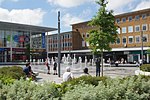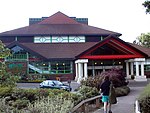Tilgate Park

Tilgate Park is a large recreational park situated south of Tilgate, South-East Crawley. It is the largest and most popular park in the area. Originally a 2,185-acre (8.84 km2) part of the ancient Worth Forest, the park and adjacent areas (including the modern-day Furnace Green, Three Bridges, part of Southgate and Tilgate Forest) were part of the larger Tilgate Estate. Although visitor activity is mostly focused on the area surrounding Tilgate Lake and on the adjacent gardens of a former country mansion, a large area of the park is former silvicultural forest. This is now being managed as a Local Nature Reserve called Tilgate Forest. The park also contains the Tilgate Nature Centre featuring captive breeding of some vulnerable and endangered animal species and varieties.
Excerpt from the Wikipedia article Tilgate Park (License: CC BY-SA 3.0, Authors, Images).Tilgate Park
Tilgate Drive,
Geographical coordinates (GPS) Address Nearby Places Show on map
Geographical coordinates (GPS)
| Latitude | Longitude |
|---|---|
| N 51.09425 ° | E -0.17801388888889 ° |
Address
Tilgate Drive
RH10 5PG
England, United Kingdom
Open on Google Maps









